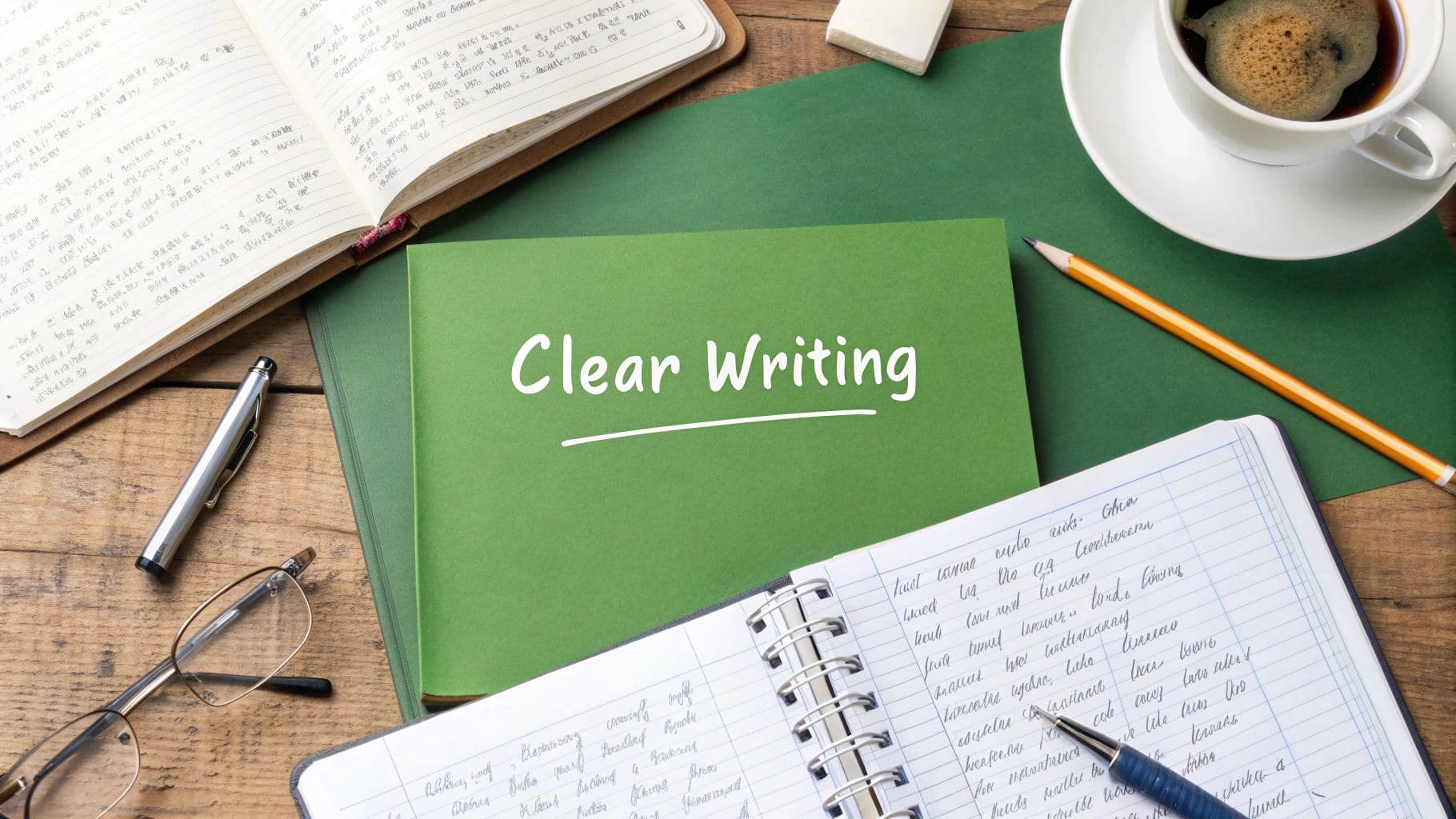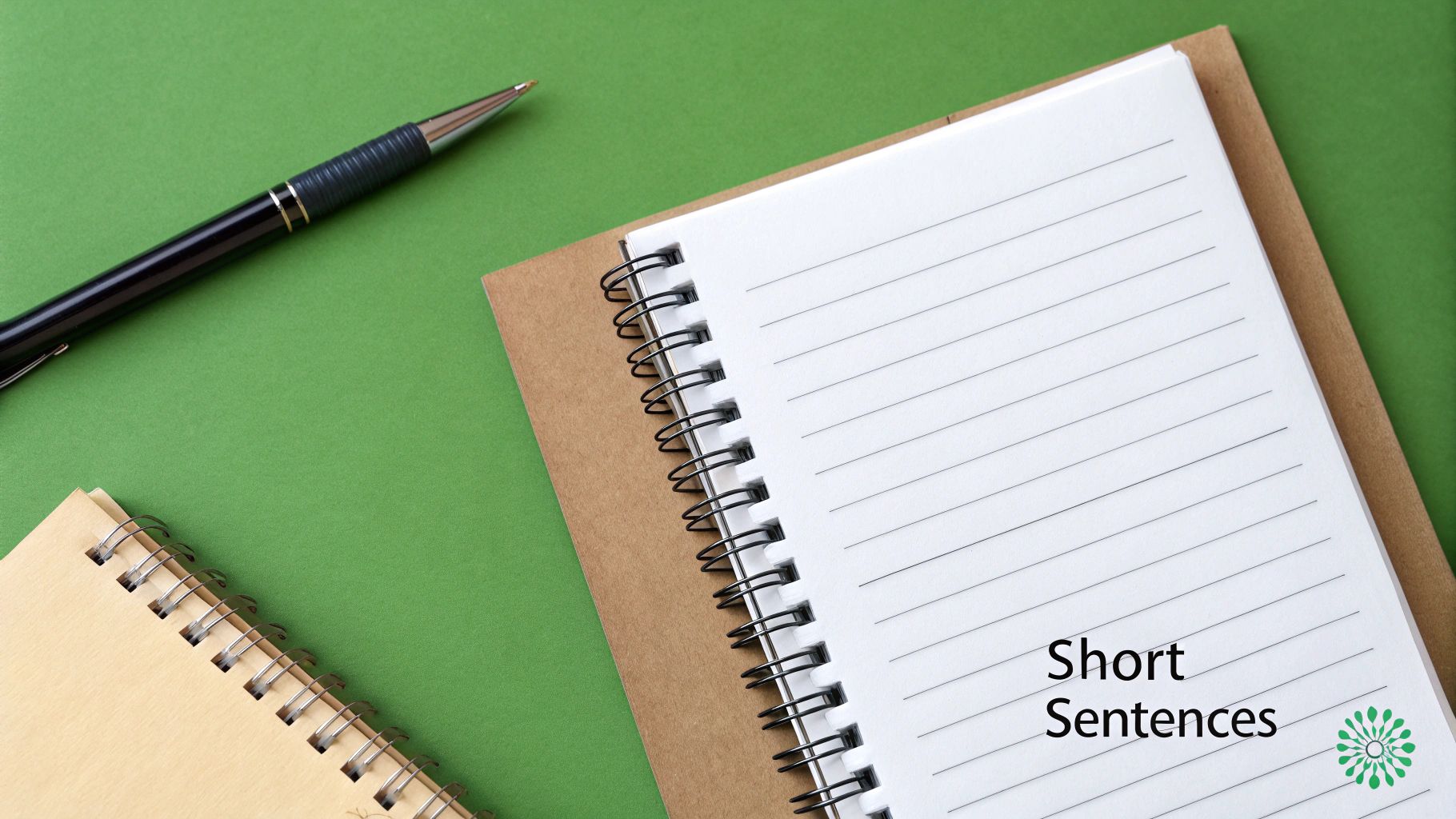
8 Essential Tips for Clear Writing in 2025
June 20, 2025
Why Clarity is the Cornerstone of Powerful Writing
In a world saturated with information, clarity is not just a stylistic choice; it is a strategic advantage. Vague, convoluted writing creates friction, causing readers to lose interest, misunderstand your message, or dismiss your ideas altogether. Truly effective communication cuts through the noise. It respects the reader's time, builds trust, and ensures your message is not only received but also understood and acted upon. This guide offers eight essential tips for clear writing, designed to help you refine your sentences, structure your thoughts, and communicate with precision and impact.
Whether you're crafting an academic paper, a business proposal, or a blog post, these actionable strategies will transform your work from confusing to compelling. From choosing the right words to ruthlessly editing your drafts, each tip provides a practical framework for achieving effortless clarity. We will explore specific techniques, such as:
- Mastering the active voice to create direct and energetic prose.
- Constructing short, simple sentences for maximum readability.
- Eliminating unnecessary words that dilute your core message.
- Using concrete language to paint a vivid picture for your audience.
By implementing these principles, you will learn to write with an authority and directness that captures and holds your reader's attention from the first sentence to the last.
1. Use the Active Voice
One of the most effective tips for clear writing is to prioritize the active voice. In an active sentence, the subject directly performs the action described by the verb. This structure creates a more direct, concise, and engaging narrative. The alternative, the passive voice, often makes sentences wordy and can obscure who is responsible for the action, leading to confusion and a weaker impact on the reader.

Consider the difference. The passive sentence, "The project was completed by the team," is less powerful than its active counterpart, "The team completed the project." The active version is shorter and clearly identifies the doer. Similarly, "Mistakes were made" is a classic passive construction that avoids responsibility. The active form, "We made a mistake," is direct, accountable, and far clearer.
How to Implement the Active Voice
To shift your writing from passive to active, start by identifying the true subject of your sentence-the person or thing performing the action. Then, restructure the sentence so that the subject comes first.
- Spot the passive voice: Look for a form of the verb "to be" (is, are, was, were, been) followed by a past participle (e.g., was driven, is considered).
- Ask "who did what?": This simple question helps you pinpoint the actor and the action. Place the actor at the beginning of the sentence.
- Be direct: Eliminate unnecessary words that often accompany passive constructions, such as "by the..." or "it was found that..."
While the active voice is generally preferred, the passive voice has its place. Use it strategically when the actor is unknown, unimportant, or when you want to emphasize the object of the action. For instance, in scientific writing, "The samples were heated to 100°C" is appropriate because the focus is on the samples, not the researcher who heated them. Exploring these nuances is key to mastering effective writing strategies.
2. Write Short, Simple Sentences
A foundational pillar of clear writing is the use of short, simple sentences. This approach enhances readability and ensures your core message is understood without unnecessary effort from the reader. Long, convoluted sentences filled with multiple clauses can obscure your point and cause readers to lose focus. By breaking complex ideas into smaller, more digestible units, you make your writing more accessible, direct, and impactful. This principle is not about dumbing down your content; it's about respecting your reader's time and cognitive energy.

This method is championed by masters of clarity. Consider the punchy, declarative style of Ernest Hemingway, whose prose remains powerful due to its directness. In the modern era, Apple's product descriptions are a masterclass in simplicity, conveying sophisticated technology through straightforward language. Instead of a long sentence like, "The new laptop, which has been re-engineered with a powerful M3 chip that provides unprecedented speed and efficiency, also features a stunning Liquid Retina XDR display for vibrant visuals," they would break it down. "The new laptop is supercharged by the M3 chip. It delivers incredible performance. And the Liquid Retina XDR display is simply gorgeous." This makes the information easier to absorb.
How to Implement Short, Simple Sentences
Adopting this style requires conscious effort and editing. The goal is to make each sentence carry its own weight without being overloaded. One of the best tips for clear writing is to prioritize one central idea per sentence.
- Aim for one idea per sentence: Before you write a comma or a connecting word, ask if you are introducing a new, distinct thought. If so, start a new sentence.
- Break down complex thoughts: Locate long sentences in your draft and find natural pause points, often around conjunctions like "and," "but," or "while." Split them into two or more shorter sentences.
- Read your work aloud: This is a powerful technique. If you find yourself running out of breath while reading a sentence, it's a clear sign that it's too long.
- Vary sentence length for rhythm: While short sentences are key, a text composed entirely of them can sound robotic. Strategically mix in slightly longer sentences to create a more engaging and natural flow. The key is to make simplicity the default, not the only option.
This approach is highly valued by the Plain Language Movement, which advocates for clear communication from government and other institutions. By focusing on concise sentence structure, you ensure your message resonates with a broader audience and achieves its intended purpose with greater efficiency.
3. Eliminate Unnecessary Words
One of the most powerful tips for clear writing involves cutting out everything that doesn't add value. Removing redundant words, filler phrases, and overly complex constructions creates tighter, more impactful prose. This practice, often called writing with economy, forces you to focus on the essential message while respecting your reader's time and attention. Concise writing is not about making things shorter for the sake of it; it's about making every word count.

Think about the difference between a verbose sentence and its concise counterpart. The phrase, "Due to the fact that the meeting was long, we missed our deadline," is clunky. A much cleaner version is, "Because the meeting was long, we missed our deadline." Similarly, "At this point in time, we need to proceed" can be simplified to "We need to proceed now." Each revision delivers the same meaning with greater force and clarity, demonstrating how strategic cuts improve readability.
How to Eliminate Unnecessary Words
To make your writing more direct, you must actively hunt for and remove verbal clutter. This editing skill sharpens your focus on core ideas and strengthens your overall message.
- Hunt for filler phrases: Search for common culprits like in order to, due to the fact that, at this point in time, and for all intents and purposes. Replace them with single words like to, because, and now.
- Cut weak sentence starters: Eliminate constructions like "There is" or "There are" when possible. Instead of "There are three reasons why this plan will work," write "This plan will work for three reasons."
- Remove redundant qualifiers: Words like very, really, quite, and just often weaken your writing. Instead of saying something is "very important," use a stronger word like "essential" or "critical."
Applying these trimming techniques is a crucial step in refining any draft. By pruning away the excess, you allow your key points to stand out more prominently. This approach ensures your writing is not only easier to read but also more persuasive and professional. Mastering the art of conciseness is fundamental to developing a strong, authoritative voice and providing a better experience for your audience.
4. Use Specific, Concrete Language
One of the most powerful tips for clear writing is to favor specific, concrete language over vague, abstract terms. When you use precise words, you paint a clear picture in your reader's mind, eliminating guesswork and ambiguity. Abstract language forces the reader to interpret your meaning, while concrete language shows them exactly what you intend. This specificity makes your writing more memorable, engaging, and persuasive.

Consider the impact of detail. A vague statement like, "The business saw significant growth last year," leaves much to the imagination. In contrast, "The business increased its revenue by $50,000 and expanded its customer base by 20%" provides tangible, undeniable proof. Similarly, describing "poor weather" is less effective than stating there was "heavy rain and 35 mph winds." The concrete version provides clarity and helps the reader visualize the scene accurately.
How to Implement Specific, Concrete Language
To make your writing more vivid and direct, focus on replacing generalizations with precise details. This practice transforms bland statements into compelling narratives and arguments.
- Replace general nouns with specific ones: Instead of "dog," try "Golden Retriever." Instead of "car," specify "a red Ford Mustang."
- Use strong action verbs: Vague verbs often need adverbs to prop them up. For instance, "walked quickly" can be replaced by stronger, more evocative verbs like "rushed," "scurried," or "hurried."
- Include numbers and measurements: Quantify your claims whenever possible. Numbers provide hard evidence and make your points more credible and easier to grasp.
- Appeal to the five senses: Describe what can be seen, heard, smelled, tasted, or touched. This sensory detail helps readers experience your writing, not just read it. This is a core principle of showing, not telling, a technique that builds immersive worlds for your audience.
5. Organize Ideas Logically
A critical component of clear writing is presenting your ideas in a logical, predictable sequence. When content is well-structured, readers can easily follow your train of thought, connect concepts, and retain key information. A disorganized piece forces the reader to work too hard, leading to confusion and abandonment. A logical structure, on the other hand, provides a clear roadmap from introduction to conclusion, ensuring your message is not just read, but understood.
Consider a proposal that presents a solution before defining the problem it solves. The reader will be immediately lost. A more effective approach is the Problem-Solution structure, where you first detail the challenge and then introduce your proposed fix. Similarly, a process description is most effective when presented in chronological order. Different goals require different structures, from compare-contrast for evaluations to the inverted pyramid model used in journalism to deliver the most crucial information first.
How to Implement Logical Organization
To ensure your writing is logically structured, you must plan before you begin writing. Creating an outline is one of the most powerful tips for clear writing because it forces you to arrange your thoughts coherently.
- Create an outline: Before drafting, sketch out your main points and supporting details. This blueprint ensures ideas flow logically and prevents you from straying off-topic. For complex documents, a detailed outline is indispensable. You can find excellent guidance on building a research paper outline that can be adapted for any writing task.
- Use topic sentences: Each paragraph should begin with a clear topic sentence that introduces its main idea. This signals to the reader what the paragraph will cover and how it connects to the overall argument.
- Employ transitional phrases: Use words and phrases like "consequently," "in addition," "however," and "on the other hand" to create smooth bridges between sentences and paragraphs. These transitions guide the reader through your reasoning.
- Group related ideas: Keep similar concepts together. Dedicate distinct sections or paragraphs to each core theme to avoid jumping between different topics, which can disorient your audience.
By consciously organizing your content, you make it significantly easier for your audience to process and accept your message. A strong structure is the invisible framework that holds compelling writing together.
6. Write for Your Audience
One of the most foundational tips for clear writing is to tailor your message to its intended audience. Effective communication is not a one-size-fits-all endeavor; it requires adapting your vocabulary, tone, and depth of detail to the people you are addressing. Writing for your specific audience ensures that your content is not only understood but also resonates, engages, and achieves its purpose, whether that's to inform, persuade, or educate.
Consider the vast difference in approach needed for various scenarios. A financial report detailing quarterly performance for investors will be dense with data and specific terminology. The same company's internal memo about financial health for employees would be simplified, focusing on what the numbers mean for their roles. Similarly, explaining a medical diagnosis to a patient requires simple, empathetic language, while a report for a medical journal would use precise, technical terminology. Ignoring the audience's needs is a fast track to miscommunication.
How to Write for Your Audience
To effectively tailor your content, you must first understand who your readers are. This research phase is crucial for aligning your message with their expectations and knowledge level.
- Research your readers: Identify their demographics, existing knowledge, and reason for reading. Are they experts seeking technical data or beginners needing a simple overview?
- Adjust your vocabulary: Avoid jargon and acronyms if your audience is unfamiliar with them. Conversely, use specialized language when writing for experts to demonstrate credibility and precision.
- Provide relevant context: Use examples, analogies, and references that your readers will recognize and understand. This makes complex ideas more accessible.
- Consider the cultural context: Be mindful of cultural norms, idioms, and sensitivities that could affect how your message is received, especially for a global audience.
Ultimately, writing for your audience is about empathy. It means stepping into your reader's shoes and asking, "What do they need to know, and how can I present it in the clearest way possible?" This reader-centric approach is fundamental to creating content that connects and persuades. Developing this skill is essential for anyone looking to write compelling content that makes a lasting impact.
7. Use Parallel Structure
One of the most powerful yet subtle tips for clear writing is to use parallel structure. Also known as parallelism, this principle involves using a consistent grammatical pattern when structuring lists, series, or compared ideas. This consistency creates a pleasing rhythm and makes your sentences balanced and easy for the reader to process. Without it, sentences can feel clumsy, disjointed, and confusing, forcing the reader to work harder to understand your point.
Consider the famous line from Julius Caesar: “I came, I saw, I conquered.” Its power lies in its perfect parallel structure of three short, past-tense verb phrases. If it were written "I came, I was seeing things, and then conquest was achieved," the impact would be completely lost. Similarly, a job description listing responsibilities as “Developing marketing plans, you will manage social media, and budget creation” is jarring. The parallel version, “Developing marketing plans, managing social media, and creating budgets,” is far more professional and clear.
How to Implement Parallel Structure
To implement parallelism, ensure that words and phrases in a series or list share the same grammatical form. This creates a logical and rhythmic flow that enhances readability.
- Check lists and series: Make sure every item in a list begins with the same type of word. If the first item is a verb ending in "-ing," all subsequent items should be as well.
- Balance compound sentences: When connecting two ideas with conjunctions like "and," "but," or "or," try to keep the clauses grammatically similar. For example, "She loves to swim, but she hates to run."
- Read your work aloud: Your ear can often catch a break in rhythm that your eye might miss. If a sentence sounds awkward or unbalanced, it likely has a parallelism issue.
Mastering parallel structure is a key step toward more sophisticated and persuasive prose. It not only improves clarity but also adds a layer of polish and authority to your work, making it a vital skill in any collection of tips for clear writing. By paying attention to the balance and rhythm of your sentences, you guide your reader smoothly through your ideas.
8. Edit and Revise Ruthlessly
Truly clear writing is rarely achieved in the first draft. The secret to transforming a rough, rambling document into a polished, effective piece lies in ruthless editing and revision. This systematic process involves multiple passes, each targeting a different aspect of the text, from big-picture structure and flow to sentence-level clarity and grammatical correctness. It’s the same discipline seen in professional publishing, where a manuscript undergoes several rounds of review before it ever reaches the reader.
Think of it as sculpting. The first draft is just the block of stone; revision is where you carve out the form, and editing is where you polish the fine details. For example, a corporate communications team doesn’t send out a press release after one draft. It goes through approvals and revisions to ensure the message is airtight, on-brand, and unambiguous. Adopting this multi-stage approach is one of the most powerful tips for clear writing because it separates the creative act of writing from the analytical act of refining.
How to Implement Ruthless Editing and Revision
To edit effectively, you must create distance from your work and approach it with a critical eye. Instead of trying to fix everything at once, break the process into manageable stages.
- Take a break: Step away from your draft for a few hours or even a day. This mental space helps you see your writing more objectively, making it easier to spot errors and awkward phrasing.
- Read it aloud: This simple trick helps you hear clunky sentences, repetitive words, and areas where the rhythm is off. If a sentence is hard to say, it’s probably hard to read.
- Edit in passes: Focus on one thing at a time. First, check the overall structure and argument. Next, refine paragraph and sentence structure. Finally, proofread for grammar, spelling, and punctuation.
- Get feedback: Ask a trusted colleague or friend to read your work. A fresh pair of eyes can catch mistakes and points of confusion that you've become blind to.
This disciplined approach is not about nitpicking; it's about ensuring your final message is as clear and impactful as possible. By systematically reviewing your work, you move beyond just "good enough" and produce writing that truly connects with and informs your audience. Professional writers, from journalists to novelists like Anne Lamott, swear by this process because they know that clarity is crafted, not just written.
8 Essential Tips for Clear Writing Comparison
| Writing Strategy | Implementation Complexity 🔄 | Resource Requirements ⚡ | Expected Outcomes 📊 | Ideal Use Cases 💡 | Key Advantages ⭐ |
|---|---|---|---|---|---|
| Use the Active Voice | Low | Low | Clear, direct, engaging text | General writing, persuasive texts | Increases readability, assigns clear responsibility |
| Write Short, Simple Sentences | Low to Medium | Low | Increased comprehension | Digital content, general communication | Improves readability, reduces misunderstandings |
| Eliminate Unnecessary Words | Medium | Medium | Concise, impactful writing | Editing drafts, professional documents | Saves space, increases clarity and reading speed |
| Use Specific, Concrete Language | Medium | Medium | Memorable, vivid writing | Marketing, storytelling, technical writing | Builds credibility, reduces ambiguity |
| Organize Ideas Logically | Medium to High | Medium to High | Better comprehension, retention | Academic, business, persuasive writing | Strengthens arguments, facilitates scanning |
| Write for Your Audience | Medium | Medium | Higher engagement, relevance | Targeted content, marketing, education | Increases effectiveness, reduces miscommunication |
| Use Parallel Structure | Low to Medium | Low | Rhythmic, clear prose | Speeches, presentations, marketing copy | Enhances flow, aids retention |
| Edit and Revise Ruthlessly | High | High | Polished, error-free writing | Publishing, academic, professional documents | Dramatically improves quality, catches errors |
Transform Your Writing from Good to Great
Mastering the art of clear writing is not a destination you arrive at, but a continuous journey of refinement. The eight foundational strategies we have explored are your toolkit for this journey. They are not isolated tricks but interconnected principles that, when practiced together, create a powerful synergy. From the dynamic energy of the active voice to the precision of short sentences, each tip for clear writing contributes to a single, vital goal: making your message resonate with your intended reader.
Think of these principles as layers of polish. Eliminating unnecessary words cleans the surface, allowing your core ideas to shine. Using specific, concrete language adds texture and depth, making abstract concepts tangible. A logical structure provides a sturdy frame, guiding your reader effortlessly from one point to the next. When you combine these with audience awareness, parallel structure, and a ruthless editing process, the result is writing that is not just understood, but felt.
Putting Clarity into Practice
The true value of these techniques emerges not from simply knowing them, but from consistently applying them. The ultimate benefit extends far beyond a clean sentence; it is about building trust, fostering understanding, and driving meaningful action.
To begin this transformation, choose just one or two principles to focus on during your next writing project.
- For your next academic paper or report: Concentrate on logical organization and using concrete language to explain complex data.
- For your next marketing campaign: Prioritize writing for your specific audience and using the active voice to create a compelling, urgent message.
- For your next blog post: Focus on eliminating fluff words and shortening your sentences to improve readability on screen.
This targeted approach makes the process manageable and helps build strong habits over time. The goal is to internalize these tips for clear writing until they become second nature, an intuitive part of your creative process.
The Lasting Impact of Clear Communication
Ultimately, clarity is an act of respect for your reader's time and intellect. Whether you are a student striving for a better grade, a marketer aiming to convert leads, or a blogger hoping to build a loyal following, your success hinges on your ability to communicate with precision and power. Clear writing ensures your brilliant ideas are not lost in a fog of confusing jargon or tangled sentences. It empowers you to inform, persuade, and inspire effectively. Committing to these practices is an investment in your own voice and a promise to make every word count.
Ready to accelerate your journey to pristine clarity? Many of these principles, from cutting wordiness to improving flow, can be implemented instantly with the right tool. Try Natural Write to humanize AI drafts and polish your text with a single click, ensuring your message is always natural and impactful.


